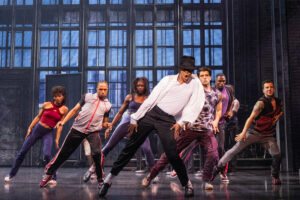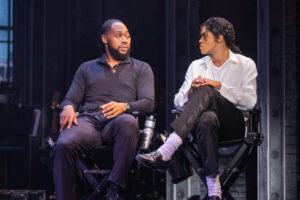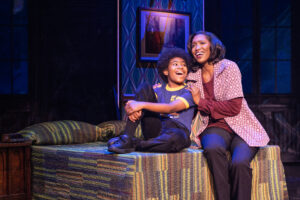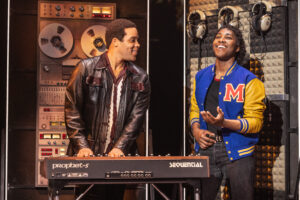MJ: another Jukebox Musical at TPAC

The sensational new musical MJ the Musical is running at TPAC’s Andrew Jackson Theater. I was able to see the performance on the evening of April 29th, 2025 from within a sold-out hall, and it was wonderful! The story, which is light even for a jukebox musical, is set in the period just before his Dangerous World Tour in 1992, opening on a rehearsal stage. In an age of Beyoncé and Taylor Swift it might be hard to remember, but Michael Jackson’s tours were worldwide, extravagant, theatrical, unprecedented and, in 1992, he ruled as the King of Pop. The narrative is an image of the star, at the top of his game, performing 40 musical numbers and it provides an often-rosy biography through glimpses into the past.

As the title character, Jordan Markus was remarkable. He had the moves, the presence, the charisma, the body type, and even the weird, breathy, and upper-register spoken voice. Markus’ dancing was astounding, and his soft-spoken management of people around him seemed realistic. As the younger versions of Jackson, Erik Hamilton, Quenton Blanton Jr., and Bane Griffith were also quite believable. Devin Bowles as his supportive manager, who also ingeniously doubled as his demanding father, Joseph Jackson, played both roles perfectly, and the narrative did very well to portray Joseph in a more sophisticated manner than I expected it might—his demanding and abusive nature is described as a (successful) effort to create resilience on the part of his talented son. His mother was played by the remarkable Anastasia Talley who brought the best voice in the house. Hers is the character of a protective, suffering and loving mother but without any real depth or complication.
Christopher Wheeldon’s direction and choreography are charming with a strong sense of period and nostalgia. The dancing troupe was, if anything, too exuberant. Overall, it is a musical that buys into the fictional reality of Michael Jackson’s videos and public persona; this is how one can understand why they chose 1992. While many of the idiosyncrasies were well known by then (the Elephant Man’s bones, Bubbles the Chimp, sleeping in the hyperbaric chamber, etc) they were just part of the “weirdo narrative” often connected to the lives of a child star.

However, the pedophilia accusations, which wouldn’t start until the next year (1993), go largely unaddressed in the musical. (At one point they might be mentioned in the musical when his business manager asks Jackson “you’re bringing a family on tour?” with no further clarification—is this the Cascio Family?) The musical’s pro-Jackson bias is probably a result of, and if not, it at least resulted in, the Jackson estate’s support, and for this, the press has not received this musical well. The accusations in the 2019 documentary Leaving Neverland, had a powerful impact, strong support (and rebuttals) even as the court cases are ongoing, but if it’s one thing that we have learned in the 21st century, we can’t always trust what we see on the silver screen– “fact” or “fiction.” They say that a man should be considered innocent until proven guilty, and this musical takes that idea seriously.
My primary criticism for the musical is as an arts historian; there are so many things about MJ’s art that we don’t know but we should. The position that Michael Jackson held in our culture is fantastically easy to underestimate. As a dancer, the moves he created, or at least brought mainstream, including the “robot” (first on Soul Train, 1973), the “moonwalk,” (first on Motown 25, 1983), the lean (Smooth Criminal, 1987), and many others are iconic watersheds. The musical attempts to place him in a historical context by literally bringing out his influences—Fred Astaire, Bob Fosse, James Brown, and even the Nicholas Brothers, is well-intentioned, but they appear onstage for only an instant. There is no effort to portray the connections in style, form and innovation that are so apparent when viewed side by side.

Similarly, having Quincy Jones onstage beside Michael Jackson, without revealing musical details of that collaborative relationship and its influence is a huge missed opportunity. Jackson’s singing, the change in his voice across his life, the roles he played in his videos, his vocalizations (squeals, yelps, wooo!) and how they created his complex of sound are unaddressed. Finally, they have his look and fashion down, but what did it all mean to him? Why only one glove? Why white socks? Why such a genderfluid expression—exaggerated masculine gestures from within an outwardly androgynous or feminine form—a dandy as it were (a timely subject for sure!) There is a fictional MTV interviewer onstage, annoyingly, throughout the musical. Yet, they ask the same old wrong questions, and Jackson’s answers are almost always ambiguous. I want more from biography, even if it is jukebox musical biography.
What I do know is that when the house lights came up and all the big hits were reprised, the dancing audience wasn’t concerned with the possible behaviors or expressive intentions of a tortured child-star. They weren’t considering how the King of Pop’s aesthetics are echoed in nearly everything about modern pop culture. They were reliving their own youth and an innocence that has long since waned. This was the purpose of the evening, and in that, Wheeldon and company were, again, quite successful. Go see it, dance your heart out and wring your hands about it later if you must!



